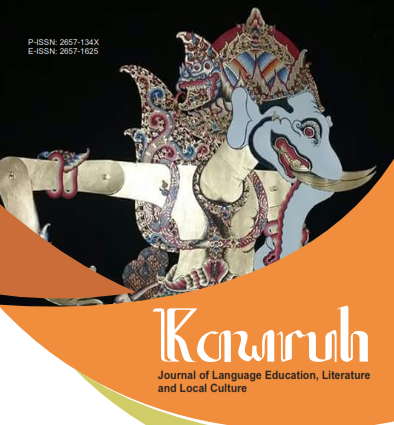Hakikat Kekuasaan Dalam Lakon Wahyu Purba Sejati Karya Ki Seno Nugroho
DOI:
https://doi.org/10.32585/kawruh.v4i1.2248Kata Kunci:
The essence of power, subtlety, memayu hayuning bawana, revelation, Javanese shadow puppetAbstrak
This paper discusses the essential of power in the wayang play entitled Wahyu Purba Sejati by Ki Seno Nugroho. There are quite a number of wayang kulit purwa plays with the theme of revelation, such as: Wahyu Makutharama, Wahyu Purba Kayun, Wahyu Darma, Wahyu Pancadarma, and others. One of wayang kulit purwa play that is unique in the last decade is Wahyu Purba Sejati play, presented by Ki Seno Nugroho. The power in this play is divided into four, namely Cahyaningrat, Reksakaningrat, Yuwananingrat, and Wimbaningrat. How the essential of power is constructed in the play Wahyu Purba Sejati by Ki Seno Nugroho is the main problem in this research. Creswell's qualitative method and Benedict Anderson's theory of power are used to analyze this issue of power. The study resulted in the finding that the concept of power in the play Wahyu Purba Sejati essentially refers to the gift of God's supernatural power given to humans who like to do inner work in a quiet place in their orientation to create world peace. Power is knowledge that contains subtleties, achieved through athe process of implementing self-control which functions to maintain world harmony by eradicating chaos, injustice and unrighteousness, in order to create a safe, peaceful, prosperous life. This study concludes that power is cosmic and magical (supernatural) which is represented by the acquisition of revelation as a manifestation of the achievement of certain social strata (wahyu kraton, wahyu patih, wahyu wahdat, and wahyu induk). Power is not only a tool that has the potential to be destructive, but it can also potentially be a means to meddle hayuningbawana (seek world peace).Unduhan
Referensi
Budiardjo, Miriam. dkk. (1984). Aneka Pemikiran Tentang Kuasa dan Wibawa. Jakarta: Pustaka Sinar Harapan.
Creswell, J.W. (2010). Research Design: Pendekatan Kulitatif, Kuantitatif, dan Mixed.Yogyakarta: PT Pusaka Pelajar.
Darmoko. (2020). Wacana Kekuasaan dalam Wayang: Pergulatan Sanggit Politik dan Sanggit Estetik dalam Wayang Kulit Purwa Lakon Semar Mbabar Jatidiri. Depok: PusatDokumentasi Seni Indonesia.
_____. (1992). Wahyu Purbasejati Tinjauan Atas Wahyu. Laporan Penelitian. Depok. Fakultas Sastra Universitas Indonesia.
_____. (1998). Wahyu Dalam Lakon Wayang Kulit Purwa. Depok: Fakultas Sastra Universitas Indonesia.
_____. (2017). Wayang Kulit Purwa Lakon Semar Mbabar Jatidiri: Sanggit dan Wacana Kekuasaan Soeharto. Disertasi. Depok: Universitas Indonesia.
Endraswara, Suwardi. (2013). Falsafah Kepemimpinan Jawa. Jakarta: PT Buku Seru.
Groenendael, Victoria M. Clara van. (1987). Dalang di Balik Wayang. Jakarta: PT Pustaka Utama Grafiti.
Hapsari, Raniska Mitra. (2012). Makna Wahyu Purba Sejati dalam Budaya Jawa. Depok: Fakultas Ilmu Pengetahuan Budaya Universitas Indonesia.
Jumiati, Ika. (2018). Pengaruh Pendidikan Kesehatan Terhadap Pengetahuan Dan Sikap Bullying Pada Siswa Di SD Negeri 01 Ngesrep Kecamatan Banyumanik Kota Semarang. Semarang: Universitas Muhamadiyah
Kuncoro, Bimo. (2016). “Mitologi Lakon Wahyu Eka Bawana dalam Pandangan Masyarakat Sangiran.”PantunJurnal Ilmiah Seni Budaya Vol.1 No.1 Juni 2016 (22-30)
Magnis-Suseno, Franz. (1984). Etika Jawa: Sebuah Analisa Falsafi tentang Kebijaksanaan Hidup Jawa. Jakarta: Gramedia Pustaka Utama.
Mahdiah, Nada Qonita dan Darmoko (2019). “Laku dan Pengetahuan Spiritual Ki Ageng Pandhanaran dalam Lakon Wedhare Sedat Tembayat.” Jurnal Kawruh Vol. 1 No. 2 Oktober 2019 (57-79)
Murtana, I Nyoman. (2008). “Ajaran Inkarnasi dalam Lakon Wahyu Purbo Sejati”. Mudra Jurnal Seni Budaya(65-79).
Peursen, C.A. van. (1989). Strategi Kebudayaan. Yogyakarta: Kanisius.
Poerwadarminta, W.J.S. dkk. (1939). Baoesasta Djawa. Sebagai acuan buku kamus Jawa-Belanda karya T.H. Pegeaud. Batavia: J.B. Wolters Uitgevers Maatschappij N.V. Groningen.
Priyanto & Darmoko. (2012). Modul Mata Kuliah Seni Wayang. Depok: Universitas Indonesia.
Ratu Agung, Yusuf. (2007). Ngudi Kasampurnaan: Langkah Pencapaian Eksistensi Diri Mausia Jawa. Malang: Univertitas Islam Negeri.
Siswoharsojo. (1958). Pakem Padhalangan Lampahan Wahju Purbasedjati dhapukan Gagrag Surakarta. Ngajogyakarta: Ki Siswoharsojo.
Soetarno, dkk. (2007). Sejarah Pedalangan. Surakarta: ISI Surakarta.
Sunardi. (2013). Konsep Dasar Estetika Pertunjukan Wayang. Surakarta: ISI Press.
Suryanto, Isbodroini. Gunawan. (2005). “Faham Kekuasaan Jawa: Pandanan Elit Kraton Surakarta dan Yogyakarta”. Jurnal Antropologi Vol. 2.No. 29
Teeuw, A. (1988). Sastra dan Ilmu Sastra: Pengantar Ilmu Sastra. Jakarta: PT Dunia Pustaka Jaya.
Tim Penulis Senawangi. (2013). Ensiklopedi Wayang Indonesia. Jilid 1-6. Jakarta: Yayasan SENA WANGI.
Wicoyo, Joko. (1991). Konsep Kekuasaan Jawa Dalam Kehidupan Sosial Politik. Fakultas Ilmu Politik. Universitas Gajah Mada. Jogjakarta.
Zuhri, Amat. (2015). “Etika Kewarganegaraan Dalam Serat Wulangreh”. Sabda: Jurnal Kebudayaan Indonesia Vol. 10, No. 2.
Unduhan
Diterbitkan
Cara Mengutip
Terbitan
Bagian
Lisensi
Authors who publish with the Kawruh: Journal of Language Education, Literature and Local Culture agree to the following terms:
- Authors retain copyright and grant the journal the right of first publication with the work simultaneously licensed under a Creative Commons Attribution License (CC BY-SA 4.0) that allows others to share the work with an acknowledgment of the work's authorship and initial publication in this journal.
- Authors are able to enter into separate, additional contractual arrangements for the non-exclusive distribution of the journal's published version of the work (e.g., post it to an institutional repository or publish it in a book), with an acknowledgment of its initial publication in this journal.
- Authors are permitted and encouraged to post their work online (e.g., in institutional repositories or on their website) prior to and during the submission process, as it can lead to productive exchanges, as well as earlier and greater citation of published work.

